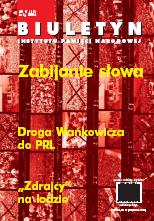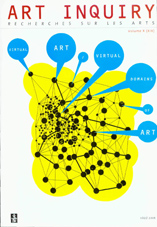




Keywords: Polish literature
More...
Keywords: Polish contemporary history; communist Poland; communism in Poland
More...

Keywords: Tygodnik Powszechny; Polish Church; Communism in Poland
More...


The concept of the machine as an extension of the human body or a kind of prosthesis is rooted in European cultures (cf.. the mechanical dolls created in ancient times, which can be regarded as the prototypes of robots). The concept of cyborgs is part of contemporary imagery. A cyborg may be perceived as a creation of imagination, inhabiting s/f films and novels, but also as an element of modern reality, a hybrid who changes the relationships between nature and culture, by making technology indispensable to its life. Referring to this Janus creature in the present volume, I use the term cyborg in a double meaning: firstly when I talk about the creation of human imagination, futurological projections and speculations; secondly to refer to the modern man preoccupied with technology. It is difficult to draw clear boundaries between fiction and reality; one is reflected in the other. Fiction and imagination allow us to perform a mental experiment of creating a different version of ourselves – for example a human as an electro-mechanical art project. This project is the subject of the article.
More...
The paper addresses the issue of new developments in the field of curating in the context of information technologies. It explores the emergence of an interdisciplinary approach that directly links the field of curating with computer programming and a relatively recent interest in software art. Although there is much contemporary critical work and practice that is described as art-oriented programming or software art, the paper responds to a perceived gap in the discussions about software curating. It is important to emphasise that in this context software curating is not to be understood as the activity of curating software art works (in other words the activity of bringing software artworks into public domain) but as integrating software and programming in the curatorial process per se. Furthermore, the paper reflects upon the recent rise of popularity of social technologies and their relevance for curating. The underlying suggestion is that curating responds to this by developing new forms that increasingly involve socio-technological networks and that can be characterised as socially driven and distributed over networks.
More...
How does the young generation of artists, shaped by electronic media, perceive the world? How do art universities react to the changes of culture, caused by widespread application of the, so called, information technologies? How does the media reality (mediated experience) influence perception? Which new competences does new operational perception, necessary for establishing a relation with the artifact, require from the artist and the interactor? The author’s educational experience, acquired in recent years, is the basis for reflection on Polish art after the change of political system, and above all after massive emerging of communication technologies on the cultural market.
More...
The inspiration and momentum for pursuing digital art as concept in Japan may well have been incubated in the early avant-garde groups of the 1950s and 1960s. Early pioneers in digital media have evolved their conceptual ideas using digital technology and interactive media. Recently, there has been a burgeoning interest in documenting the history of digital media within the international art and technology movement that is so prevalent today. What was once referred to as “computer art”, has earned the new title “digital media” in the art world, but in the field of art history it is beginning to fade into the larger art category of “new media” which includes performance, installation, environmental art, and other ventures that do not necessarily include technology. In an effort to document the interest in technology within avant-garde art groups in Japan, the purpose of this paper is to show that the attitude toward the exploration of materials and processes of the 1950s and 1960s led to a continued search for new types of media. This attitude naturally led to experiments with technology and eventually opened the way toward the digital realm and the use of computer algorithms and interactivity in the fine arts in Japan.
More...
Media interactions, based on a mix of visual iconographies that are complex and highly mediated, are often presented within a remediation framework as the product of immediacy exchanges between the object and the viewer. Within these media structures that are in flux between the real and the virtual, the transitional remediation concept of old media to new media by Jay David Bolter and Richard Grusin is not sufficient to explain the interactions between technological structures, creative behaviors, emotive interactions and images. The over-layering processes and hybridizations between media that create new languages and sublanguages, both textual and visual, generate new recontextualizations that blend and blur the boundaries with the concept of “body” as a media language which also acts as an emotive filter and reflects upon the methodological media engagements characterized by immediacy as well as hypermediacy, social issues of instantaneousness, biofeedback responses and dromology. The article will conclude by discussing the necessity to recover the meaning and the emotive aspect of the interpretations and representations of the concept of reality and virtuality, together with their mythological and social implications. It will support the research for a new circuit of meanings and emotive interactions that offers an evolutionary space for the remediation of the form as well as transmediation of the content within the context of contemporary new media platforms.
More...
One of the most important problems concerning the dissemination of cyber arts is the “variable” and “unstable” character of that kind of art. The Web offers the possibility to create archive platforms for digital works of art. Yet perhaps instead of archives, we should rather talk about expanded virtual museums. The goal of such institutions would be the archivisation, presentation and dissemination of digital data about such types of artistic activity as, for example, interactive installations, genetic art, software art, virtual art, net art, transgenic art, telematics, etc. The Database of Virtual Art, Media Art Net, ArtBase, netzspannung.org and the archives of the international festivals for new media art (Ars Electronica, transmediale, DEAF) – are examples of the different strategies of the preservation and dissemination of digital art on the Web.
More...
The author takes into consideration the problems of interactive art. He analyzes the subject matter in a double context of social interaction and HCI, and examines the structure of interactive situations, their actors, forms of interaction and interfaces, presenting numerous examples of interactive artworks. Using as an example the oeuvre of Myron Krueger, the author then presents the development of interactive art, the conflict between artistic experience understood as contemplation and that understood as interaction, the development of the forms of interactive art understood as interpersonal interaction/communication in the technological context, the interaction with the responsive environment, and finally, the merger of both. He then presents some models of interactive art and models of the proces of interactive artistic communication. In the end, the author presents an open typology of interactive artworks, analyzing in turn an instrument work, a game work, an archive work, a labirynth work, and a rhizome work.
More...
One of the many virtual worlds inspired by the cyberpunk literature movement, Second Life has attracted global attention since 2006 and counts millions of residents today. Aligned with the Web 2.0 trends and considered by many as the best digital life at the present moment, the SL Metaverse1 gives flow to cybrid processes. Despite not being a complete novelty – since 3D MUVEs (Multi User Virtual Environments) and social networks have existed on the Web for more than a decade – Second Life brings several new questions and possible influences in language and personal relationships that cannot be ignored. The objective of this paper is to briefly explore the new possibilities for expression and interaction provided by Second Life and other virtual worlds on the Web, especially in art, and to present reflections about their probable influence on the future navigation interfaces on the web. Some selected artworks in Second Life will be pointed out to illustrate the paper.
More...
The article concerns the description of various phenomena connected with identity, which human can be subjected to in the Net. Accordingly, the processes have been presented which take place mainly within 3D electronics environment. These environments possess an ability to cause a strong immersion, which „engages” human intentionality, and also provides possibility for self-creation. For a description of the phenomena of translocating human activity to the Net, two processes have been indicated: incorporation process, i.e. receiving of an electronic body, e.g. of avatar, and existential process, i.e. human involvement in electronic environment which exceeds the utilitarian aspect. Both processes lead to the state of electronic incarnation, which is not related to any cause of being in the electronics environments, and becomes an autonomous value. Electronic incarnation combines with cultural and anthropological aspects, and has reflection in electronic art. Interrelation between common everyday activity with Net, influences a range of human involvement in the electronic environment, i.e. sometimes changing a user into a participant of immaterial events. On the one hand, such processes reach deeper in human, and secondly, electronic worlds, such as Second Life, create possibilities for finding there spiritual values, emotional life, and the sphere of feelings. Human subjected to immersion can begin specific „journey”, starting in front of computer’s interface, and ending in the rising of electronic personality – finding oneself in the reality alternative to the physical world, in the electronic reality.
More...
This paper examines the heterogeneous nature of the interaction space in mixed/hybrid reality systems, i.e. the systems that merge everyday, real spaces and virtual worlds, to produce new kind of environments where physical and digital objects can interact in real-time. Hybrid reality systems, in this paper, are analyzed in a theoretical framework provided by a new paradigm in human-computer interaction research (HCI), which is called Ubicomp – ubiquitous computing. One of the main goals of Ubicomp is to investigate, both theoretically and practically, the possibility of “seamless integration between real and virtual domains “. After analyzing this project I attempt to point out how the concept of hybridity is defined and what general strategies of designing interaction it may lead to.
More...
Surveillance can be perceived as one of the most important features of the world in the time of globalization. Many authors (Foucault, Deleuze, Virilio, Bauman, Lyon, to name just a few) have analyzed its influence on the development of the global media society. As surveillance systems are nearly everywhere and invade both public and private spaces, they are an inevitable factor in constructing a new form of post-optic society. The social structure and the representation of social processes have been changing according to the development of technologies, which allow optical, digital and biological methods of scanning and observation. The oppressive society of control and punishment has turned into the society in which we are facing the “global democratization of exhibitionism” (Virilio), and surveillance itself becomes “the spectacle of entertainment” (Weibel). Thus it is a complex and ambivalent phenomenon: it is terrifying and attractive at the same time; it controls and discloses, it restricts our freedom and offers the possibility of a new insight into our personal and public issues; it places us under control and offers us possibilities of personal expression.
More...